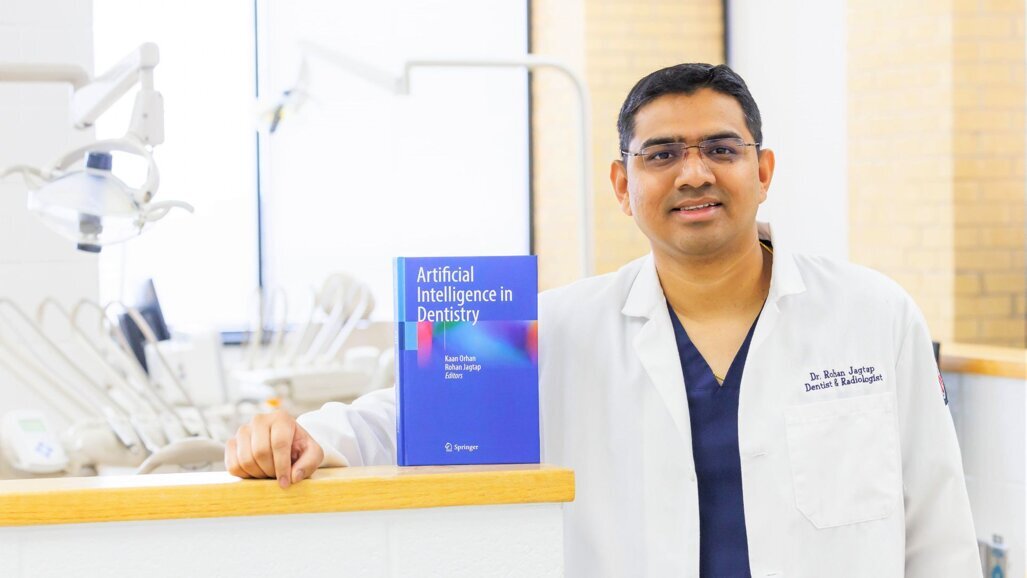Dr. Rohan Jagtap—the author of the book “Artificial Intelligence in Dentistry”—was interviewed by Dr. Amisha Parekh, PhD candidate at the University of Mississippi Medical Centre. Dr. Jagtap is the Director of the Dept of Oral & Maxillofacial Radiology. He is also the Assistant Professor in the Dept of Care Planning and Restorative Sciences at the School of Dentistry, University of Mississippi Medical Centre, USA. Read more about Dr. Rohan Jagtap
Your career path has been truly remarkable. What motivated you to specialise in the field of Oral Maxillofacial Radiology?
I never envisaged myself as a dentist, but in India, familial influence shapes career decisions. My father greatly influenced my path; he inspired me to pursue the dental field, leading me to establish my career in dentistry. A field where I've flourished for 16 years, specialising in Oral and Maxillofacial Radiology, and writing the world’s first book on “Artificial Intelligence in Dentistry”. Similarly, specialisation wasn't initially on my radar, yet my fascination with technology and the remarkable impact of CBCT imaging on dentistry captured my interest. The advent of 3D imaging has revolutionised our approach to dental care. Dr. Aniket Jadhav, an Oral and Maxillofacial Radiologist at the Virginia Commonwealth University School of Dentistry, played a pivotal role in steering me towards the field of radiology. These factors collectively motivated me to pursue a career in Oral and Maxillofacial Radiology.
What inspired you to delve into the subject of Artificial Intelligence in Dentistry?
Artificial Intelligence (AI) represents a significant advancement in dentistry, with the potential to revolutionise the field in ways previously unseen. My enduring fascination with cutting-edge dental technologies and connection with Dr. Kaan Orhan has led me to recognise the importance of integrating AI into the dental field.
I think integrating AI in dentistry promises transformative benefits across various aspects of patient care and practice management. AI offers the potential to enhance precision in diagnostics and treatment planning through advanced machine learning algorithms, leading to improved patient outcomes. The significant collaboration among experts from dentistry, computer science, and engineering fosters innovation in AI-driven solutions tailored to the specific needs of oral care.
Diagnostic tools powered by AI can revolutionise the diagnosis and monitoring of dental conditions, empowering dentists to make informed decisions and streamline treatment plans. Additionally, AI has the capacity to democratise access to dental services by overcoming geographical barriers through tele-dentistry platforms, thus improving oral health outcomes for underserved populations and narrowing the gap between supply and demand for dental services. AI can improve accuracy in diagnostics, treatment planning, and surgical procedures, leading to superior patient outcomes.
In summary, AI in dentistry offers transformative capabilities that promise to enhance precision, and diagnostic capabilities, streamline workflows, spur innovation, and improve access to care. My inclination to new technology, background in radiology, and interest in the field of clinical research have greatly inspired me to start my work in the field of Artificial Intelligence.
You’ve authored a book on Artificial Intelligence in Dentistry. Could you provide some key insights into how AI is being applied in dentistry today?
Our book on "AI in Dentistry" is regarded as a premier global resource, showcasing the diverse applications of AI across various dental specialities. It highlights AI's role in automatically detecting and segmenting anatomical structures in dental radiographs, such as teeth, maxillofacial bones, and other structures like the maxillary sinus and mandibular canal, aiding dentists in quicker and more accurate diagnosis and treatment planning.
In dentistry, AI assists in detecting alveolar bone loss, evaluating periodontal disease progression, identifying periapical lesions, and predicting various endodontic conditions. AI has made significant advancements in the detection and prediction of various aspects of endodontics, including identifying periapical lesions, crown and root fractures, root and canal morphology, working length determination, and detecting second mesio-buccal canals.
It also aids in detecting impacted teeth, cystic lesions, and oral cancers, and predicting surgical outcomes.
Prosthodontics benefits from AI in CAD/CAM technology, implant surgery template designing, aesthetic dentistry, and shade matching. AI helps in designing occlusal surfaces for crowns, determining emergence profiles in dental implantology, and creating framework designs for removable partial dentures.
AI models detect dental plaque, categorise fissure sealants, and assist in the identification of deciduous and permanent teeth, supernumerary teeth, and assessing ectopic eruption. Machine learning algorithms predict early childhood caries.
Orthodontics utilises AI for landmark detection, cephalometric analyses, diagnosis, treatment planning, growth assessment, and airway assessment. AI-driven software aids in developing personalised treatment plans, assessing individual risk factors, and facilitating remote consultations via tele-dentistry platforms.
Administratively, AI optimises dental practice management, including scheduling algorithms and virtual assistants handling patient inquiries. Overall, AI enhances diagnostics, treatment planning, patient care, and practice management in dentistry, with the potential for further innovation.
Are there any novel AI tools or technologies that have proved to be promising in enhancing diagnostics and treatment planning?
In the realm of dental AI, several companies like Velmeni, Diagnocat, CranioCatch, Pearl, Overjet, and VideaHealth are leading the charge with innovative applications. Deep learning algorithms, especially convolutional neural networks (CNNs), excel in analysing various dental images, including intraoral photographs, yielding precise diagnostics by identifying and classifying dental conditions and abnormalities.
Augmented Reality (AR) systems offer real-time guidance during procedures by overlaying virtual information onto real-world views. Natural Language Processing (NLP) techniques extract valuable insights from electronic health records (EHRs) and clinical notes, aiding in diagnoses and treatment planning. Virtual Reality (VR) training simulators revolutionise dental education by providing immersive environments for practising surgical procedures in a safe setting. These simulators offer feedback and performance metrics, refining dentists' skills and clinical proficiency.
In your opinion, what are the main challenges associated with integrating AI into dental practice?
Implementing AI in dentistry comes with several challenges:
-
- Data Quality and Privacy of Patient Data: Securing high-quality, diverse datasets for training AI models is crucial, but privacy concerns, data silos, and variability in imaging techniques pose obstacles in accessing suitable dental datasets.
- Liability: Attributing liability for AI-generated therapeutic recommendations is complex, and the reproducibility and robustness of AI research results are often insufficient.
- Interoperability and Integration: The lack of interoperability among various digital systems used in dental practices hampers the adoption and effectiveness of AI solutions.
- Regulatory and Ethical Considerations: Regulatory and ethical concerns regarding patient privacy, informed consent, liability, and professional responsibility need to be addressed when deploying AI in dentistry.
- Clinical Validation and Evidence-Based Practice: Demonstrating the effectiveness and clinical utility of AI algorithms requires rigorous validation in real-world clinical settings, necessitating collaboration among researchers, clinicians, and industry partners.
- Education and Training: Dental professionals need education and training to effectively utilise AI in practice. Integrating AI into dental school curricula and offering hands-on training opportunities are essential.
- Cost and Resource Constraints: Developing AI algorithms incurs upfront costs for development, hardware, software, and staffing. Ongoing expenses for maintenance, upgrades, and data management can strain resources.
Given your extensive knowledge and experience, what advice would you offer to dental professionals interested in integrating AI into their practices but uncertain about where to start?
I would say, start by reading my book, Artificial Intelligence in Dentistry! It is the most valuable resource available worldwide, comprising 19 chapters and spanning 365 pages, with extensive contributions from clinicians, specialists, engineers, and scientists holding a combined 500 years of experience from around the globe. Each chapter includes thorough, evidence-based data, bridging the gap between theoretical knowledge and practical implementation. The book critically examines the benefits, drawbacks, and limitations of AI in dental health, offering a well-rounded perspective. Additionally, it guides readers through the medico-legal aspects of AI, ensuring responsible navigation of this groundbreaking field. It provides a forward-looking exploration of AI's potential and future applications in dentistry, paving the way for a new era in oral healthcare. This unique resource empowers readers to stay at the forefront of innovation and embrace the AI revolution in dentistry, preparing them well for the future of dental practice.
I would also say that dental practitioners need to educate themselves about AI. They need to keep up-to-date with the latest developments and advancements in AI technologies relevant to dentistry. I guest lecture globally to educate dentists and specialists on this field. Practitioners can also follow reputable journals, conferences, and industry publications to stay informed about new research findings, and attend workshops and seminars to deepen their understanding of AI tools and applications.
- Continuous Education: Dental practitioners should stay updated on AI developments relevant to dentistry through online courses, webinars, and guest lectures, like those I provide worldwide.
- Information Sources: Following reputable journals, conferences, and industry publications keeps practitioners informed about the latest research in AI and its applications in dentistry.
- Hands-on Learning: Workshops, seminars, and product demonstrations from AI companies provide valuable opportunities for practitioners to gain a deeper understanding of AI tools and applications.
- Identifying Opportunities: Reflecting on specific practice challenges where AI could offer solutions helps practitioners recognise the potential benefits of AI integration.
- Ethical Considerations: Adhering to ethical principles and patient privacy standards is paramount when incorporating AI into dental practices. Involving patients in AI discussions ensures transparency and patient-centred care.
- Starting Small: Beginning with small-scale AI implementations allows practitioners to gradually familiarise themselves with AI technologies and their impact on patient care.
In your opinion, how can dental practitioners and institutions stay updated on the latest advancements in AI in dentistry? Are there any reliable resources or organisations that you recommend?
Dental practitioners can read the white paper published by the American Dental Association titled Dentistry Overview of Artificial and Augmented Intelligence Uses in Dentistry. I had the opportunity to lead three major sections in this paper: Radiology, Pathology, and Endodontics.
(https://www.ada.org/-/media/project/ada-organization/ada/ada-org/files/resources/practice/dental-standards/ada_1106_2022.pdf)
Joining dental professional associations and societies like the ADA, IADR, and AAOMR provides access to resources, publications, conferences, and workshops focused on AI in dentistry. Subscribing to peer-reviewed scientific journals that publish research on AI in dentistry helps practitioners stay current with the latest advancements and clinical applications. Taking advantage of online courses, webinars, and continuing education programmes tailored to AI in dentistry, offered by educational institutions, professional organisations, and industry partners, enhances practitioners' knowledge and skills. Attending conferences, symposia, and workshops dedicated to dental technology and innovation provides opportunities to learn about the latest advancements in AI, network with experts, and explore collaboration opportunities. Engaging with research institutions and academic centres specialising in dental informatics and AI-driven healthcare technologies provides insights into ongoing projects and emerging trends in the field.
Are there any potential ethical considerations that dentists and researchers should keep in mind when adopting AI in patient care?
- Patient Privacy and Confidentiality: Ensuring strict adherence to data privacy and security measures throughout the AI process, from data collection to analysis, is paramount.
- Informed Consent and Transparency: Patients should be fully informed about how their data will be used in AI applications and should provide explicit consent.
- Bias and Fairness: Monitoring and mitigating biases in AI algorithms to prevent unfair treatment of certain patient groups is essential.
- Clinical Interpretability and Accountability: Developing transparent and interpretable AI models ensures that clinicians understand and can trust the recommendations made by these systems.
- Professional Judgement and Autonomy: Dentists must retain control over clinical decisions, using AI as a support tool rather than a replacement for professional judgement.
- Continued Monitoring and Evaluation: Regular monitoring, evaluation, and improvement of AI systems are necessary to maintain their safety, effectiveness, and fairness over time.
As an educator, how do you see AI impacting dental education and enhancing the learning experience for students? Are there any steps that institutions should take to prepare for this transformation?
AI has the potential to profoundly impact dental education by enhancing the learning experience for students in various ways. AI-driven adaptive learning platforms can analyse students' performance, preferences, and learning styles to tailor educational content and experiences to individual needs. AI-powered simulations and virtual reality (VR) environments offer immersive and interactive learning experiences for dental students, allowing them to practise clinical procedures, treatment planning, and patient interactions in a safe and controlled setting. These technologies provide hands-on training opportunities that complement traditional classroom instruction and clinical rotations, helping students develop clinical proficiency and confidence. AI algorithms can assist students in diagnostic interpretation and treatment planning by analysing patient data, clinical images, and case histories to generate differential diagnoses and evidence-based recommendations.
To prepare for the integration of AI into dental education, institutions should consider taking the following steps:
- Invest in faculty development and training programmes to familiarise educators with AI technologies and their applications in dental education.
- Integrate AI-related topics, such as machine learning, data analytics, and digital health, into the dental curriculum to ensure that students are equipped with the knowledge and skills needed to leverage AI in clinical practice.
- Collaborate with AI companies and research institutions to pilot AI-driven educational initiatives and evaluate their effectiveness.
- Establish guidelines and best practices for the ethical use of AI in dental education, emphasising principles of transparency, fairness, and accountability.
- Foster a culture of innovation and experimentation within the institution, encouraging faculty and students to explore creative uses of AI in teaching and learning.
Have you heard of any misconceptions or myths surrounding AI in dentistry, and how would you debunk them?
Addressing misconceptions surrounding AI in dentistry is crucial for fostering informed understanding so that professionals can make sound decisions about its integration, ultimately benefiting patient care and outcomes. Here are some common myths and their debunking:
- "AI will replace dentists": AI serves as a decision support tool, augmenting dentists' expertise rather than replacing it. Dentists retain the final authority over diagnosis and treatment decisions.
- "AI is only for large dental institutions or academic centres": AI technologies are increasingly accessible and applicable to practices of all sizes, offering cloud-based solutions and software-as-a-service options.
- "AI algorithms are always accurate": AI algorithms can be prone to errors and limitations, including biases in training data. Dental professionals must critically evaluate AI results and exercise clinical judgement.
- "AI will lead to job loss among dental professionals": AI integration is unlikely to cause widespread job loss; instead, it can create new opportunities, streamline workflows, and enhance efficiency within dental practices.
- "AI in dentistry is not secure and poses risks to patient data": Regulatory frameworks like HIPAA and GDPR, along with encryption and access controls, help mitigate security risks associated with AI in dentistry.
Lastly, considering the rapid advancements in technology and AI, what do you envision as the future of dentistry and oral and maxillofacial radiology?
The future of dentistry and oral and maxillofacial radiology (OMFR) is set for remarkable changes, thanks to advancements in technology and artificial intelligence (AI). Innovations in imaging techniques, such as CBCT, MDCT, and MRI, are enhancing the ability of OMFR professionals to thoroughly assess dental and craniofacial structures. New methods like 3D printing and virtual reality are revolutionising patient education, treatment simulations, and surgical planning.
Personalised treatment plans based on patient data are becoming more common, allowing for customised strategies and better monitoring of disease progression and treatment responses. Moving forward, collaboration across disciplines and ongoing education will be crucial for effectively using AI technologies. Dental education programmes are beginning to include AI topics, and continuing education is promoting innovation and best practices in AI-driven imaging.
The AI future also leads to robotic dentistry. An autonomous surgical robot could carry out dental treatment tasks more accurately and effectively than a human dentist, and in the near future, clinically viable dental robots may be available.
By embracing these advancements and staying at the cutting edge of technology, dentists and OMFR practitioners can improve patient care and drive the evolution of their field.
Topics:
Tags:
The AI Index is recognised globally as one of the most credible and authoritative sources for data and insights on artificial intelligence (AI). The AI ...
Dentistry is witnessing the combination of Artificial Intelligence (AI) and Augmented Reality (AR), two disruptive technologies that promise to ...
The healthcare industry is experiencing a transformative shift from a rigid, one-size-fits-all system to a personalized healthcare system guided by ...
Artificial Intelligence subsets such as machine learning (ML) and deep learning (DL) aid in recognizing disease patterns from medical data and help us to ...
LUCKNOW, India: Artificial intelligence (AI), a rapidly evolving technology, is increasingly relevant in various medical fields, including dentistry, for ...
The past few decades have witnessed remarkable progress in the application of artificial intelligence (AI) and machine learning (ML) in medicine, notably in...
Dr. Jason Griggs, Associate Dean of Research, School of Dentistry, University of Mississippi Medical Center, who was recently awarded the prestigious Wilmer...
Smart toothbrushes and intra-oral sensors that continually monitor biomarkers in the oral cavity, efficient and free dental services based on preventive and...
Artificial intelligence (AI) and machine learning (ML) have emerged as powerful tools for improving diagnosis, treatment planning, and patient monitoring in...
Artificial intelligence (AI) has emerged as a game changer in various industries, and oral healthcare is no exception. In recent years, AI has been ...
Live webinar
Wed. 14 January 2026
10:30 pm IST (New Delhi)
Dr. Théo Laplane, Dr. Robert Gottlander DDS
Live webinar
Fri. 16 January 2026
10:30 pm IST (New Delhi)
Live webinar
Mon. 19 January 2026
11:30 pm IST (New Delhi)
Philipp Kopp, Michael Seeber
Live webinar
Thu. 22 January 2026
7:30 pm IST (New Delhi)
Prof. Judith Jones D.D.S; M.P.H., Prof. Kakuhiro Fukai D.D.S., Ph.D, Dr. Bathsheba (Bethy) Turton
Live webinar
Fri. 23 January 2026
12:30 am IST (New Delhi)
Dr. Nicola M. Grande DDS, PhD
Live webinar
Wed. 28 January 2026
6:30 pm IST (New Delhi)
Live webinar
Wed. 28 January 2026
9:30 pm IST (New Delhi)
Prof. Dr. Jan-Frederik Güth



 Austria / Österreich
Austria / Österreich
 Bosnia and Herzegovina / Босна и Херцеговина
Bosnia and Herzegovina / Босна и Херцеговина
 Bulgaria / България
Bulgaria / България
 Croatia / Hrvatska
Croatia / Hrvatska
 Czech Republic & Slovakia / Česká republika & Slovensko
Czech Republic & Slovakia / Česká republika & Slovensko
 France / France
France / France
 Germany / Deutschland
Germany / Deutschland
 Greece / ΕΛΛΑΔΑ
Greece / ΕΛΛΑΔΑ
 Hungary / Hungary
Hungary / Hungary
 Italy / Italia
Italy / Italia
 Netherlands / Nederland
Netherlands / Nederland
 Nordic / Nordic
Nordic / Nordic
 Poland / Polska
Poland / Polska
 Portugal / Portugal
Portugal / Portugal
 Romania & Moldova / România & Moldova
Romania & Moldova / România & Moldova
 Slovenia / Slovenija
Slovenia / Slovenija
 Serbia & Montenegro / Србија и Црна Гора
Serbia & Montenegro / Србија и Црна Гора
 Spain / España
Spain / España
 Switzerland / Schweiz
Switzerland / Schweiz
 Turkey / Türkiye
Turkey / Türkiye
 UK & Ireland / UK & Ireland
UK & Ireland / UK & Ireland
 International / International
International / International
 Brazil / Brasil
Brazil / Brasil
 Canada / Canada
Canada / Canada
 Latin America / Latinoamérica
Latin America / Latinoamérica
 USA / USA
USA / USA
 China / 中国
China / 中国
 Pakistan / Pākistān
Pakistan / Pākistān
 Vietnam / Việt Nam
Vietnam / Việt Nam
 ASEAN / ASEAN
ASEAN / ASEAN
 Israel / מְדִינַת יִשְׂרָאֵל
Israel / מְדִינַת יִשְׂרָאֵל
 Algeria, Morocco & Tunisia / الجزائر والمغرب وتونس
Algeria, Morocco & Tunisia / الجزائر والمغرب وتونس
 Middle East / Middle East
Middle East / Middle East





























































To post a reply please login or register